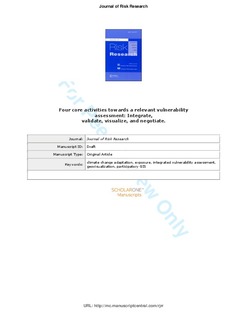Three core activities toward a relevant Integrated vulnerability assessment: validate, visualize, and negotiate
Journal article, Peer reviewed
Accepted version
Permanent lenke
http://hdl.handle.net/11250/2447556Utgivelsesdato
2015Metadata
Vis full innførselSamlinger
- Institutt for geografi [1022]
- Publikasjoner fra CRIStin - NTNU [37175]
Sammendrag
Future climate in the Nordic countries is expected to become 'warmer, wetter, and wilder', and this will probably cause more extreme weather events. Therefore, local authorities need to improve their ability to assess weather-related hazards such as floods, landslides, and storms, as well as people's sensitivity and capacity to cope with or adjust to such events. In this article, we present an integrated assessment of vulnerability to natural hazards, which incorporates both exposure and social vulnerability. In our assessment, we screen places and rank them by their relative scores on exposure and vulnerability indices. We also design a web-based visualization tool - ViewExposed - that shows maps that reveal a considerable geographic variation in integrated vulnerability. ViewExposed makes it easy to identify the places with the highest integrated vulnerability, and it facilitates the understanding of the factors that make these places exposed and/or vulnerable. For empirical validation, we correlate the exposure indices with insurance claims due to natural damage. However, we also emphasize the importance of a dialog with relevant stakeholders to ensure a participatory validation. Our top-down exposure and vulnerability assessment benefits from a participatory bottom-up assessment. This is crucial to support decisions about where to implement adaptive and preventive measures against hazards related to climate change
